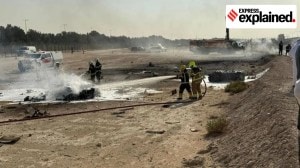Missile muscle
The launch of one Pakistani missile in answer to Agni-II was expected. The display of two in quick succession, the Ghauri-II and Shaheen,...

The launch of one Pakistani missile in answer to Agni-II was expected. The display of two in quick succession, the Ghauri-II and Shaheen, perhaps not. But expected or otherwise, the exercises are telling. What Islamabad has chosen to prove over the last year is that it is second to none in the subcontinent in its acquisition of nuclear weapons and missiles. It has not only been bent on matching India test for test in short order, it has tried to do even better with seven nuclear tests at Chagai for five at Pokharan and two missile tests for one Agni eleven months later.
To examine why Islamabad chose this moment to show off its arsenal of missiles is revealing. It is significant that it has been able to mount this latest demonstration of muscle on cue, within days of the Indian missile test. The promptness of the reply indicates that Pakistan maintains a stable of missiles which can be launched at short notice. However, the numbers are likely to be relatively small.
Reliable information is available aboutthe types and ranges of missiles in Pakistan’s possession and that it has obtained proven technology and systems over the last decade or so from China and North Korea. Its missile prowess is a more or less established fact.
Testing was therefore not an immediate necessity as would be the case for an indigenous development programme such as India’s. To have gone ahead nevertheless even at the risk of depleting a small arsenal suggests that Nawaz Sharif’s decision was driven by domestic political factors. He has professed his eagerness to build a more stable basis for India-Pakistan relations but is constrained by the fact that he is not entirely master of his own house.
There is no consensus among right wing political groups and all sections of the army establishment on the advantages of a rapprochement with India. At their urging or because of their capacity for political mischief Islamabad feels compelled, perhaps against its better judgement, to engage in military competitiveness with India even thoughit will be ultimately fruitless and self-defeating.
Indian security and foreign policy makers need to take a closer look at how domestic political factors play out in the security arena. It is much too glib in the face of the evidence to assert that there is no arms race in the subcontinent. For one, New Delhi’s argument that its nuclear and missile development programmes are a long-term insurance against trouble still has to be accepted as such across the border.
Each demonstration of fire-power by one leads to a counter-demonstration by the other. The point will not be far off when it will have to be asked how much Indian security plans are being dictated by long-term security calculations, how much by available technology and how much by the need to assuage domestic public opinion after a Pakistani “event”. Deterrence theory, for what it is worth, may have it that nuclear and missile arsenals checkmate each other and will therefore never be used. But that theory offers no help in halting an armsbuild-up, on the contrary, it stokes it. Neither country can afford this arms race.
- 01
- 02
- 03
- 04
- 05































